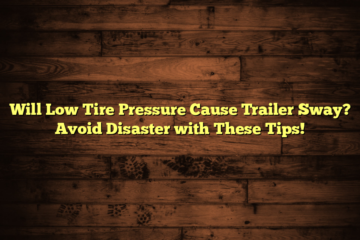What PSI Should 33 Inch Tires Be?
Determining the ideal PSI for 33-inch tires can depend on several factors including the tire’s load rating, vehicle weight, and specific use (e.g., off-road, highway driving). A common recommendation for road driving with 33-inch tires is around 35 PSI, but this can vary based on the tire’s specifications and the vehicle’s requirements. Some users have found that a PSI in the range of 26-30 provides a good balance between ride comfort and tire wear for daily driving.
Determining the correct PSI (pounds per square inch) for 33-inch tires requires a nuanced understanding of various factors including your vehicle’s specific needs, the tire’s load capacity, and the conditions under which you’ll be driving. While a general range of 28 to 35 PSI is often recommended for on-road use, the optimal pressure for your 33-inch tires can vary. This comprehensive guide is designed to help you navigate these considerations and maintain your tires for optimal performance, safety, and longevity.
Introduction to Tire Pressure and Vehicle Performance
Tire pressure is a pivotal aspect of vehicle maintenance that directly influences handling, fuel efficiency, tire wear, and safety. For 33-inch tires, which are commonly used on SUVs, light trucks, and off-road vehicles, finding the right PSI is crucial for balancing off-road capability with on-road handling and comfort.
Understanding Tire Pressure Basics
The Role of Tire Pressure
- Safety: Proper inflation is essential for the structural integrity of the tire, reducing the risk of blowouts and accidents.
- Handling and Performance: Correct tire pressure ensures better vehicle handling, braking efficiency, and overall performance.
- Fuel Economy and Tire Life: Adequately inflated tires can improve fuel economy and prevent premature tire wear, saving money and resources in the long run.
Factors Influencing Tire Pressure
Vehicle Load and Weight Distribution
Heavier vehicles or those loaded with gear may require a higher PSI in the tires to support the additional weight safely and maintain performance.
Tire Construction and Load Rating
Each tire has a maximum load rating and recommended pressure range, typically found on the tire’s sidewall. These should be carefully considered in conjunction with your vehicle’s weight and usage.
Driving Conditions and Preferences
- On-Road Use: For everyday driving on paved roads, a balanced PSI that provides comfort, efficiency, and safety is ideal.
- Off-Road Adventures: Lowering the PSI can increase the tire’s footprint, enhancing traction on unpaved surfaces. However, it’s crucial to avoid excessively low pressures that could lead to tire damage or loss of control.
Consulting Manufacturer Recommendations
Vehicle Manufacturer’s Guidelines
Your vehicle’s owner’s manual and the placard on the driver’s side door frame are primary sources for recommended tire pressures, tailored to your vehicle’s design and intended use.
Tire Manufacturer Specifications
Tire manufacturers often provide detailed guidelines on tire pressure ranges suitable for different vehicles and driving conditions. Consulting these can offer a more tailored approach to setting your tire PSI.
Tailoring PSI to Specific Driving Needs
Adjustments for Heavy Loads or Towing
When carrying heavy loads or towing, slightly increasing the tire pressure (within the tire’s safe range) can improve stability and load-carrying capacity.
Off-Road Pressure Adjustments
For off-road driving, reducing the PSI can enhance traction by increasing the tire’s contact area with the ground. It’s important to monitor tire pressure closely in these conditions to avoid damage.
Importance of Regular Tire Maintenance
Routine Pressure Checks
Regular checks, ideally monthly and before any significant trip or change in load, help maintain the optimal tire pressure.
Monitoring and Adjusting for Weather Changes
Temperature fluctuations can affect tire pressure, with cooler temperatures leading to a drop in PSI and warmer temperatures causing an increase. Seasonal adjustments may be necessary.
Tools for Accurate Pressure Measurement
Using a reliable and accurate tire pressure gauge is essential for consistent readings. Digital gauges are often recommended for their ease of use and precision.
Extended Considerations
Impact on Tire and Vehicle Longevity
Consistently maintaining the correct tire pressure can significantly extend the life of your tires and contribute to the overall longevity of your vehicle’s suspension and braking systems.
Environmental and Economic Benefits
Proper tire inflation contributes to lower carbon emissions and reduced fuel consumption, offering both environmental and economic advantages.
Conclusion
Finding the optimal PSI for your 33-inch tires is a balancing act that considers vehicle specifications, tire characteristics, driving conditions, and personal preferences. Regular maintenance and adjustments based on these factors ensure that your tires perform safely and efficiently, enhancing your driving experience and extending the life of your tires.
FAQ
How can I tell if my 33-inch tires are properly inflated?
Regular use of a quality tire pressure gauge is the most reliable method. Compare the readings with your vehicle and tire manufacturer’s recommendations, adjusting as necessary.
What should I do if I frequently switch between on-road and off-road driving?
Consider investing in an adjustable air pressure system or carry a portable air compressor to make on-the-go adjustments easier and more convenient.
Can I use the maximum PSI rating on the tire sidewall for everyday driving?
The PSI rating on the tire sidewall is the maximum pressure the tire can safely hold, not necessarily the optimal pressure for daily use. It’s best to follow your vehicle manufacturer’s recommendations for everyday driving.
How does altitude affect tire pressure?
Higher altitudes can lead to increased tire pressure due to the decrease in atmospheric pressure. Adjustments may be needed when traveling to significantly different altitudes.
Is it safe to use nitrogen in my 33-inch tires?
Using nitrogen can help maintain tire pressure stability, as nitrogen is less prone to temperature-induced pressure changes. However, regular air is also perfectly safe and effective for tire inflation.




